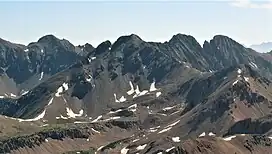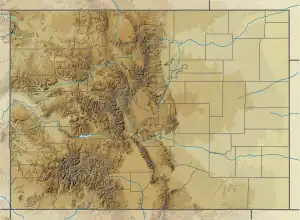| Spiller Peak | |
|---|---|
 Southwest aspect, centered (Mt. Moss to left, Babcock Peak to right) | |
| Highest point | |
| Elevation | 13,123 ft (4,000 m)[1][2] |
| Prominence | 196 ft (60 m)[3] |
| Parent peak | Babcock Peak (13,161 ft)[3] |
| Isolation | 0.55 mi (0.89 km)[4] |
| Coordinates | 37°25′40″N 108°05′14″W / 37.4279159°N 108.0872892°W[5] |
| Geography | |
 Spiller Peak Location in Colorado  Spiller Peak Spiller Peak (the United States) | |
| Country | United States |
| State | Colorado |
| County | Montezuma / La Plata |
| Parent range | Rocky Mountains San Juan Mountains La Plata Mountains[4] |
| Topo map | USGS La Plata[5] |
| Climbing | |
| Easiest route | Southeast face[2] |
Spiller Peak is a 13,123-foot-elevation (4,000-meter) mountain summit on the common boundary shared by La Plata County and Montezuma County in Colorado.[5]
Description
Spiller Peak is located 15 miles (24 km) northwest of the community of Durango on land managed by San Juan National Forest. It ranks as the fifth-highest summit of the La Plata Mountains which are a subrange of the Rocky Mountains.[4] Precipitation runoff from the mountain's west slope drains to the Mancos River and the southeast slope drains to the La Plata River. Topographic relief is significant as the summit rises 3,900 feet (1,200 meters) above the La Plata River in 2.5 miles (4.0 km) and 1,700 feet (520 meters) above Owen Basin in one-half mile (0.8 km). Neighbors include Mount Moss 0.9 miles (1.4 km) to the north-northeast and Babcock Peak 0.43 miles (0.69 km) to the east.[4] The mountain's toponym has been officially adopted by the United States Board on Geographic Names,[5] and was recorded in publications in 1906.[6] J. Calvert Spiller was a topographer with the Wheeler Survey in the 1870s. He made the first ascent of Redcloud Peak in 1874 and also named it.[7]
Climate
According to the Köppen climate classification system, Spiller Peak has an alpine climate with cold, snowy winters, and cool to warm summers.[8] Due to its altitude, it receives precipitation all year, as snow in winter and as thunderstorms in summer, with a dry period in late spring.
Gallery
See also
References
- ↑ Robert M. Ormes (2000), Guide to the Colorado Mountains, Colorado Mountain Club Press, ISBN 9780967146607, p. 320.
- 1 2 Robert F. Rosebrough, The San Juan Mountains: A Climbing & Hiking Guide, Cordillera Press, 1986, page 34.
- 1 2 "Spiller Peak - 13,134' CO". listsofjohn.com. Retrieved May 24, 2023.
- 1 2 3 4 "Spiller Peak, Colorado". Peakbagger.com. Retrieved May 24, 2023.
- 1 2 3 4 "Spiller Peak". Geographic Names Information System. United States Geological Survey, United States Department of the Interior. Retrieved May 24, 2023.
- ↑ Henry Gannett, United States Geological Survey (1906), A Gazetteer of Colorado, US Government Printing Office, p. 159.
- ↑ Chris Meehan (2016), Climbing Colorado's Fourteeners, Falcon Guides, ISBN 9781493019717, p. 79.
- ↑ Peel, M. C.; Finlayson, B. L.; McMahon, T. A. (2007). "Updated world map of the Köppen−Geiger climate classification". Hydrol. Earth Syst. Sci. 11. ISSN 1027-5606.
External links
- Weather forecast: Spiller Peak

